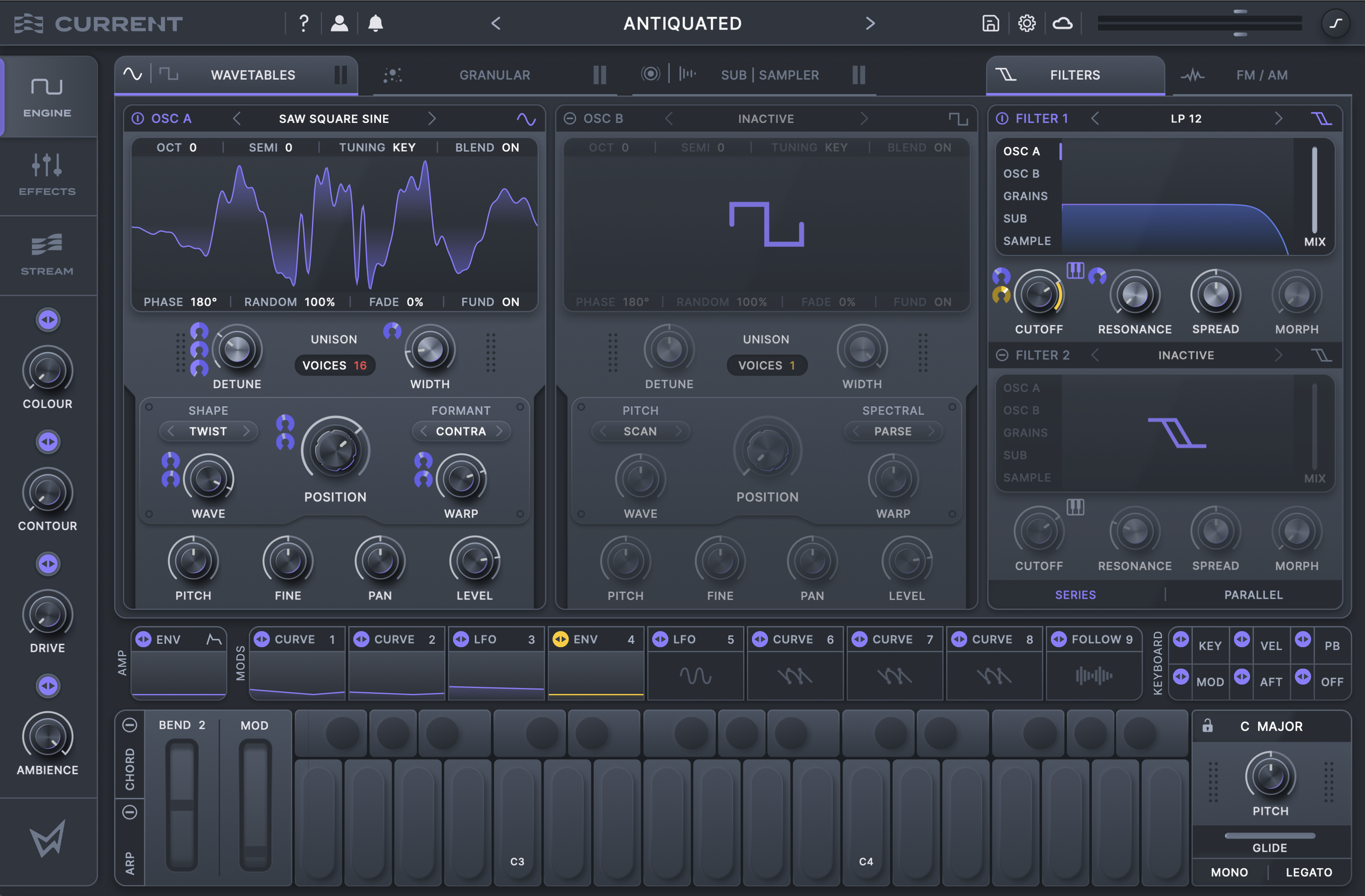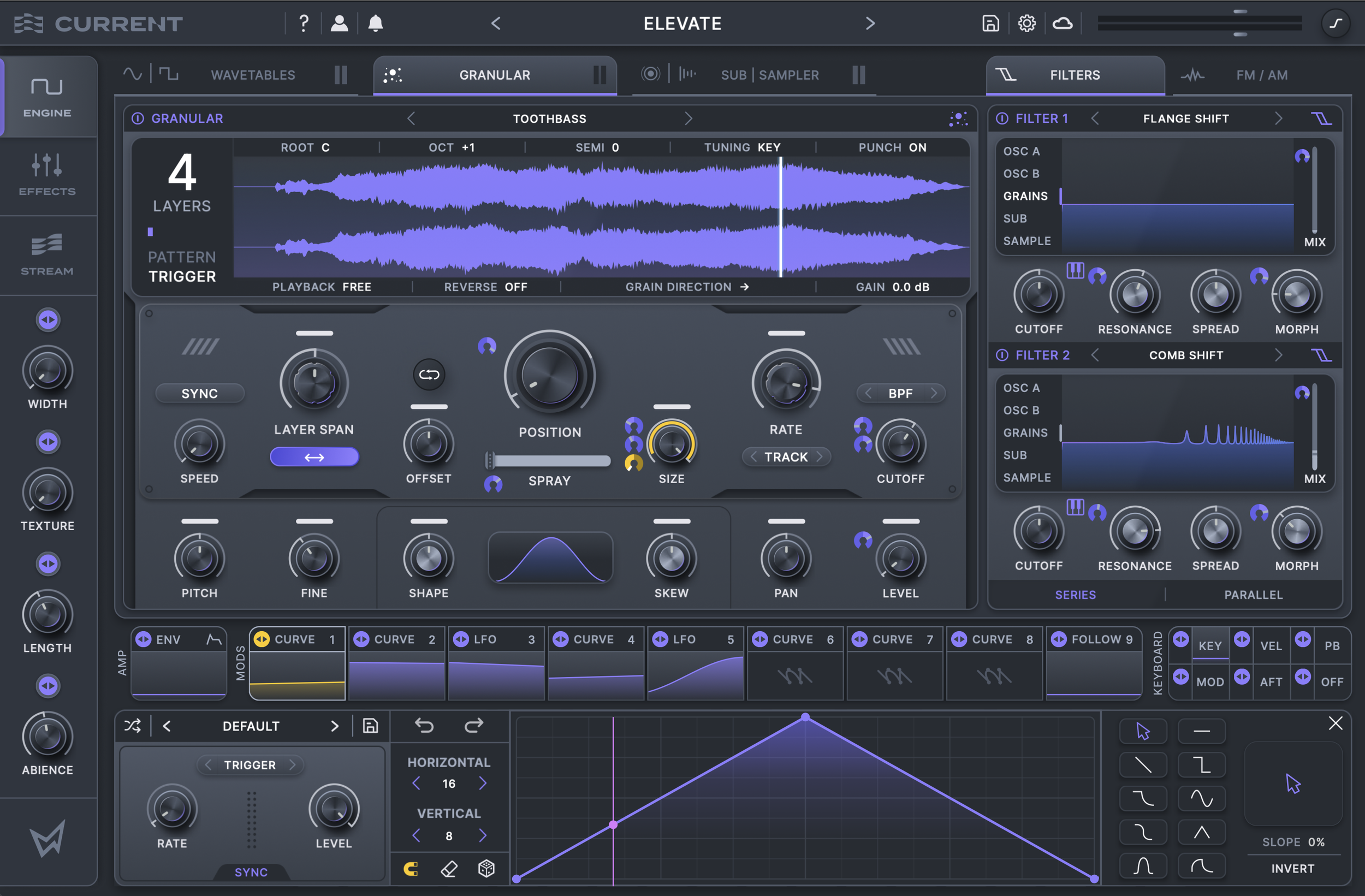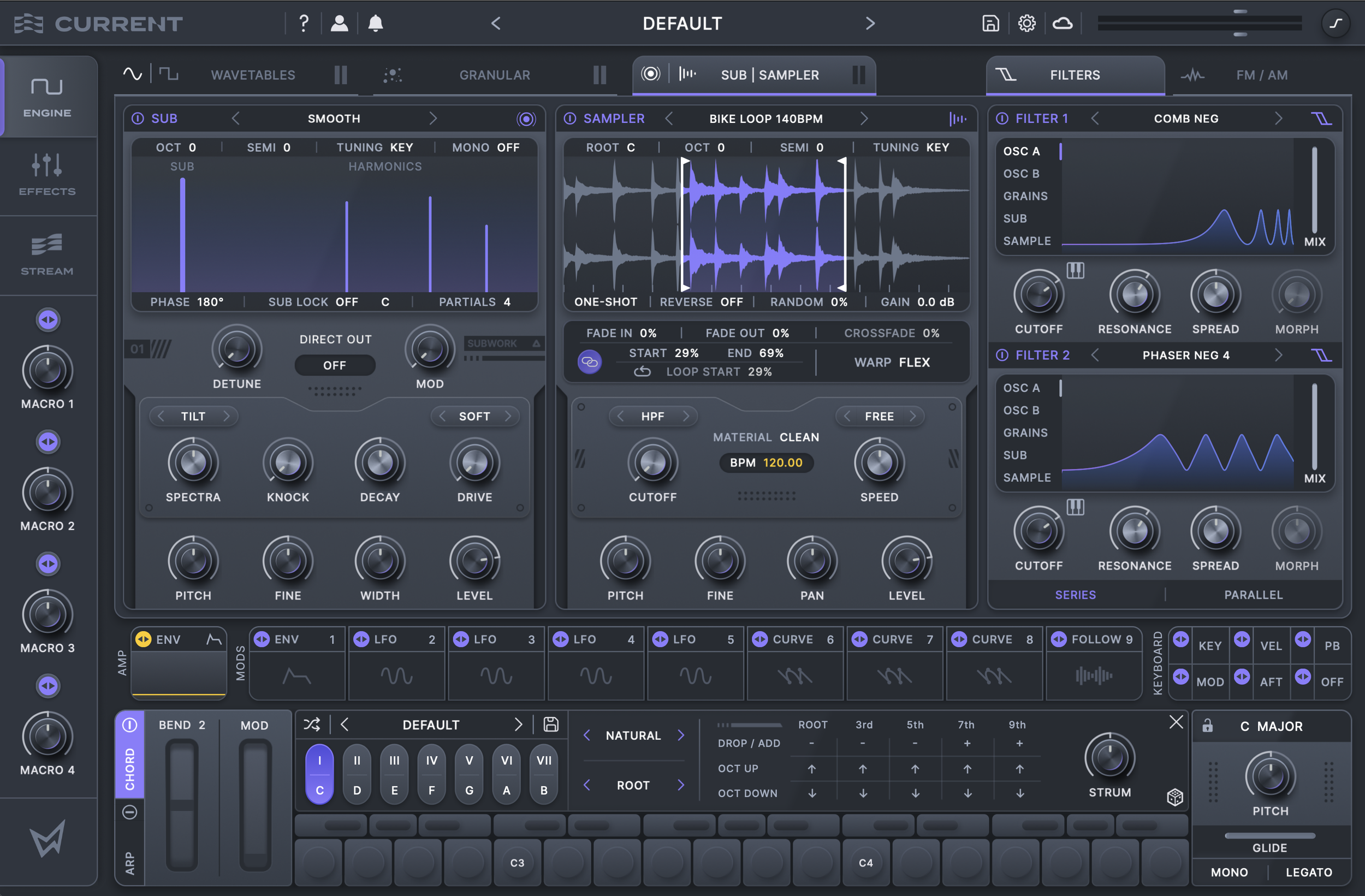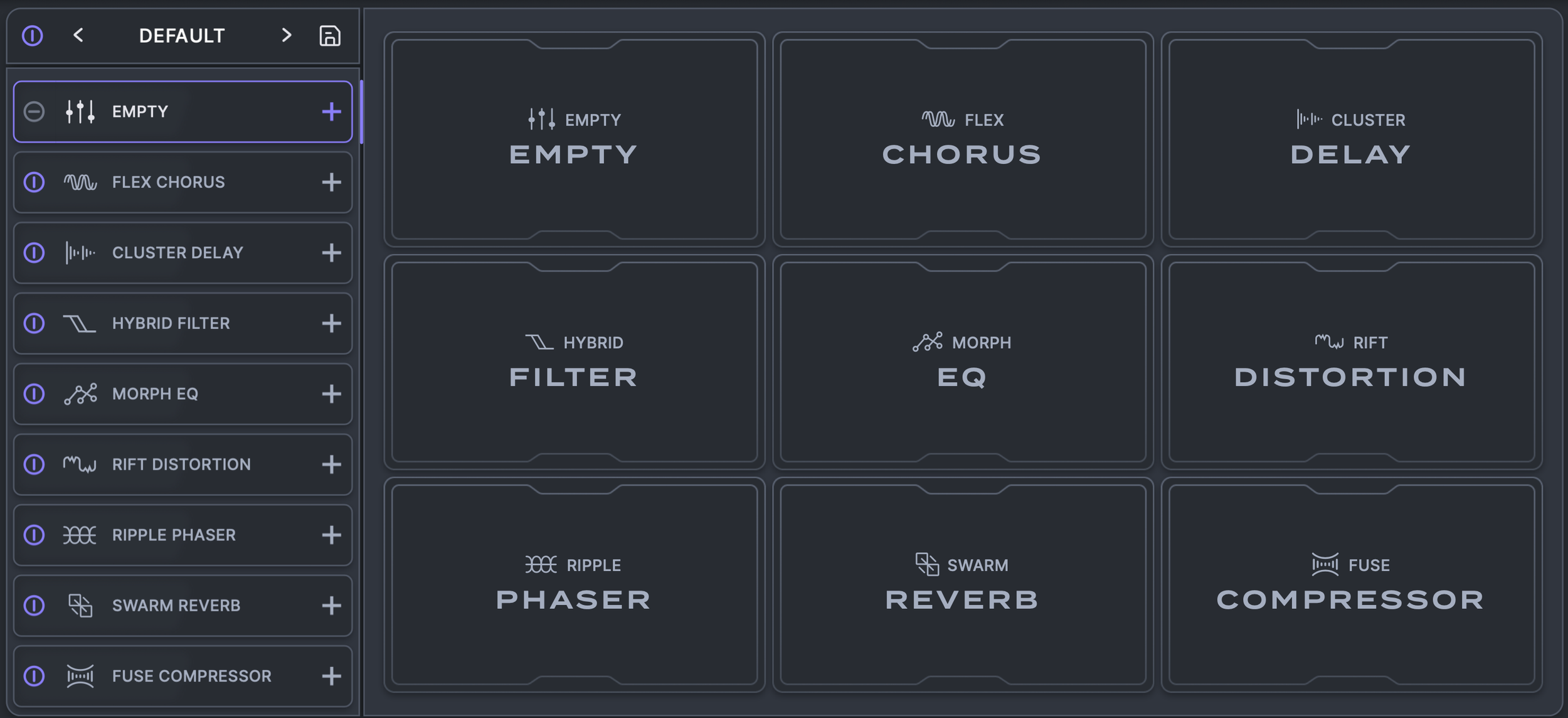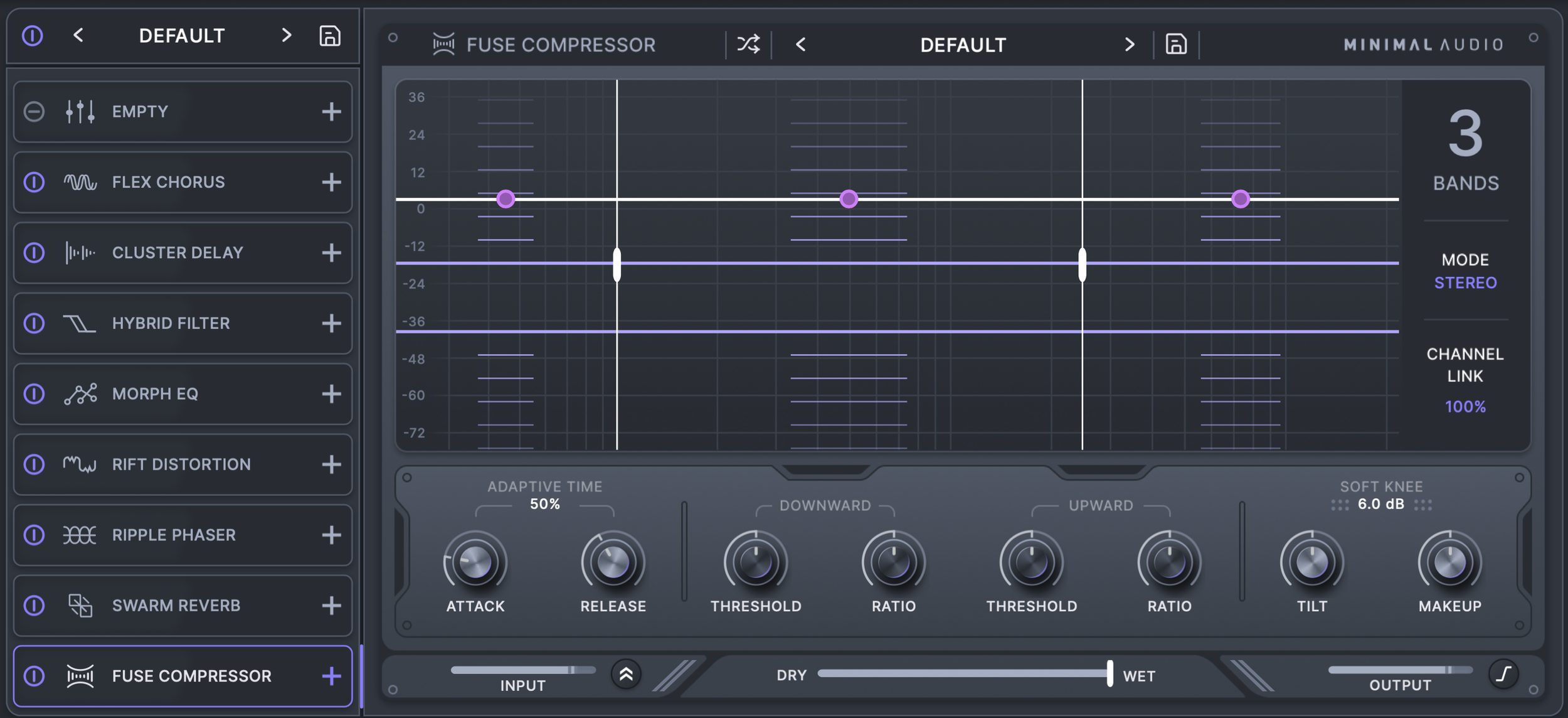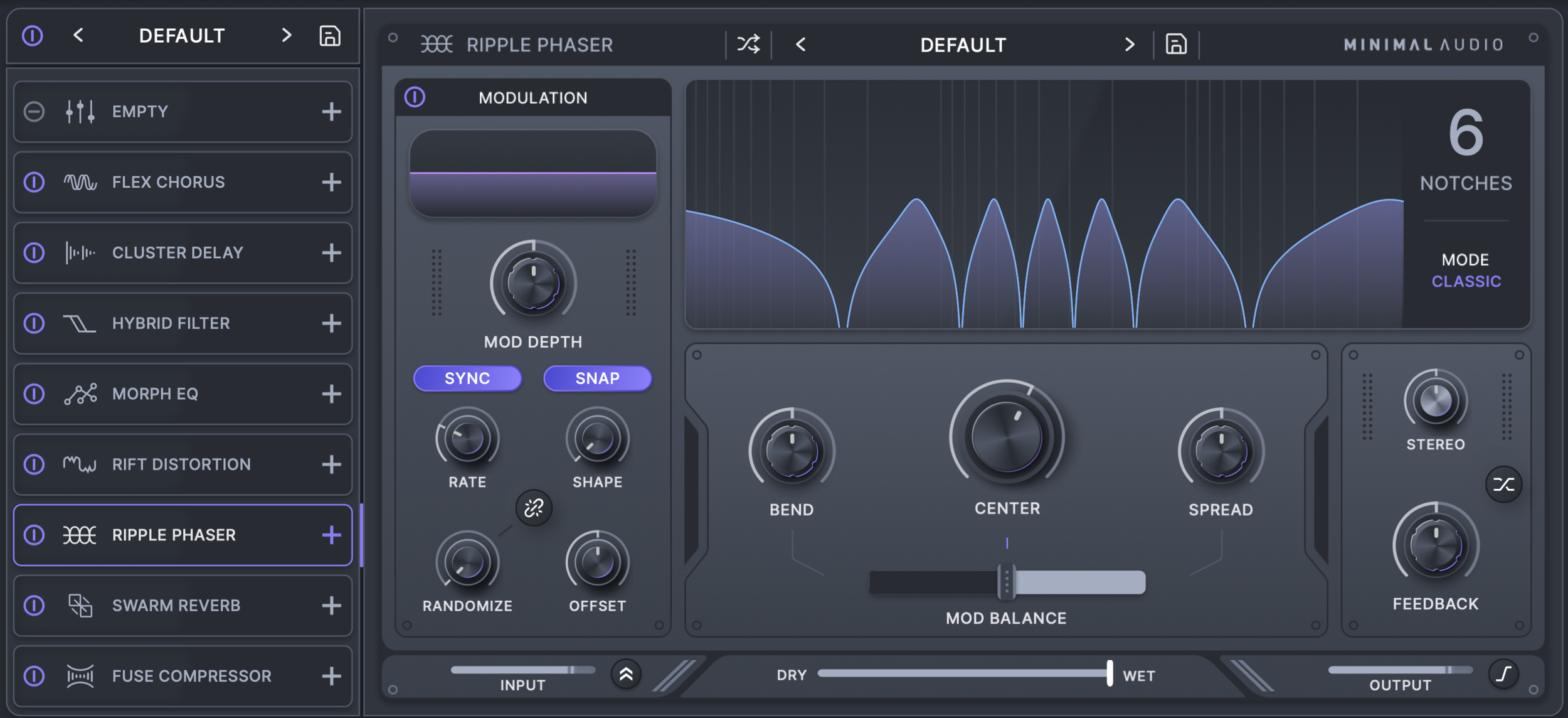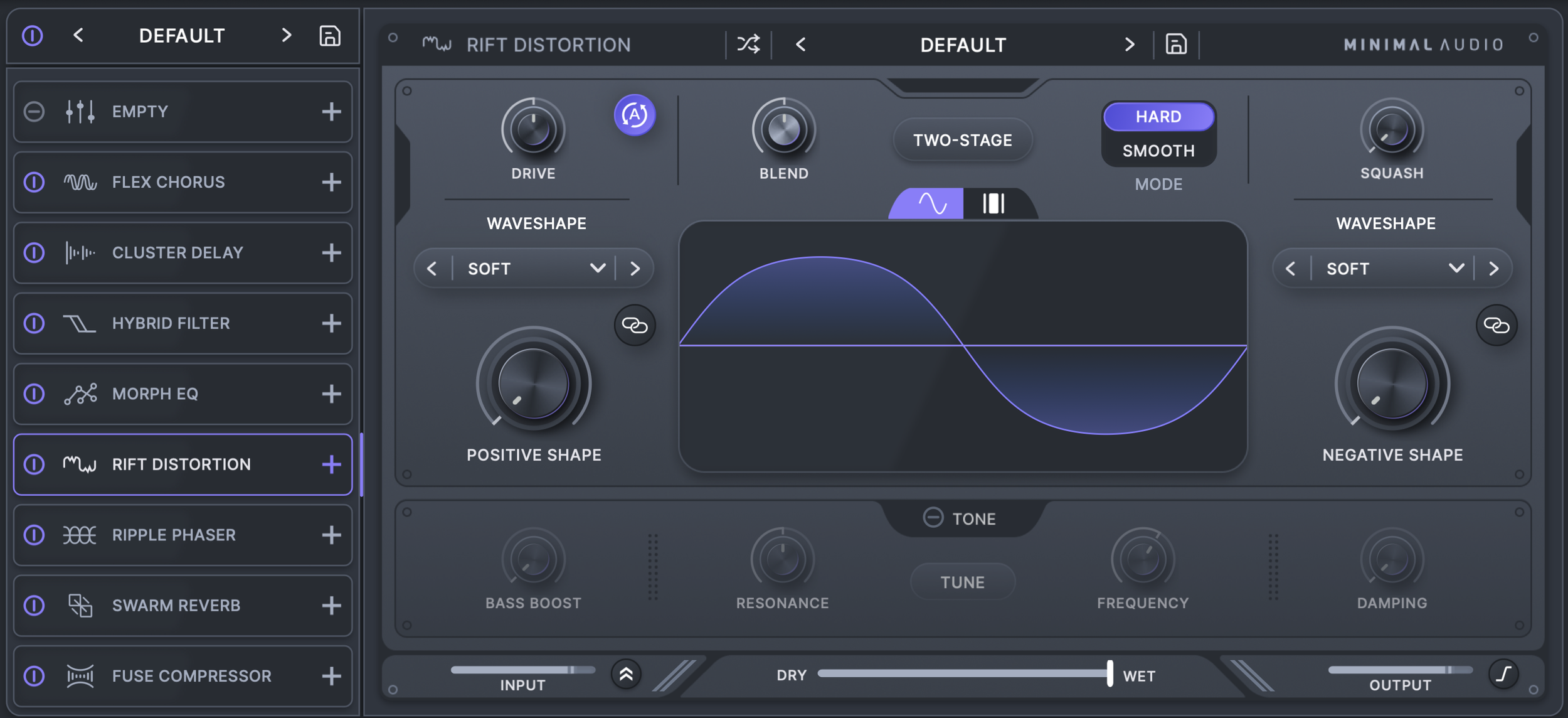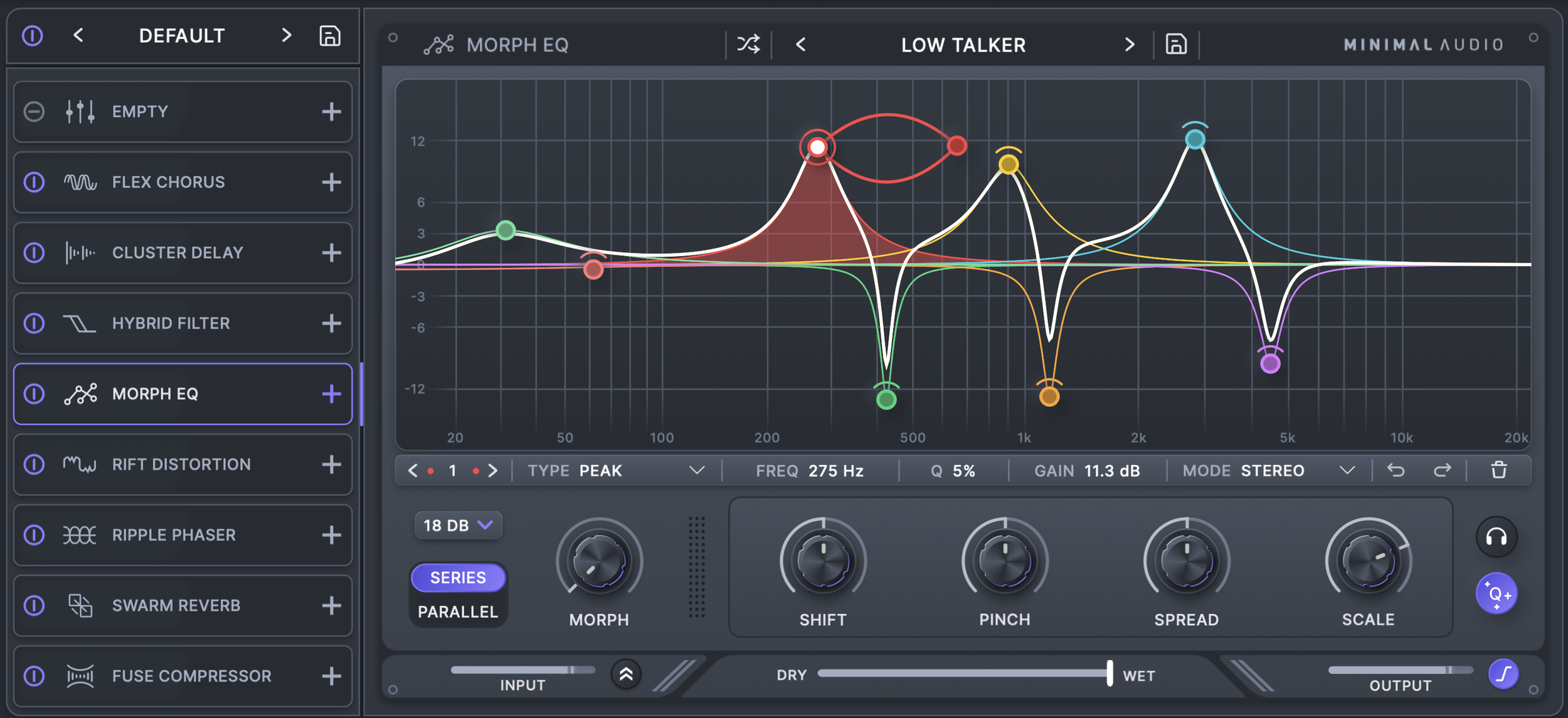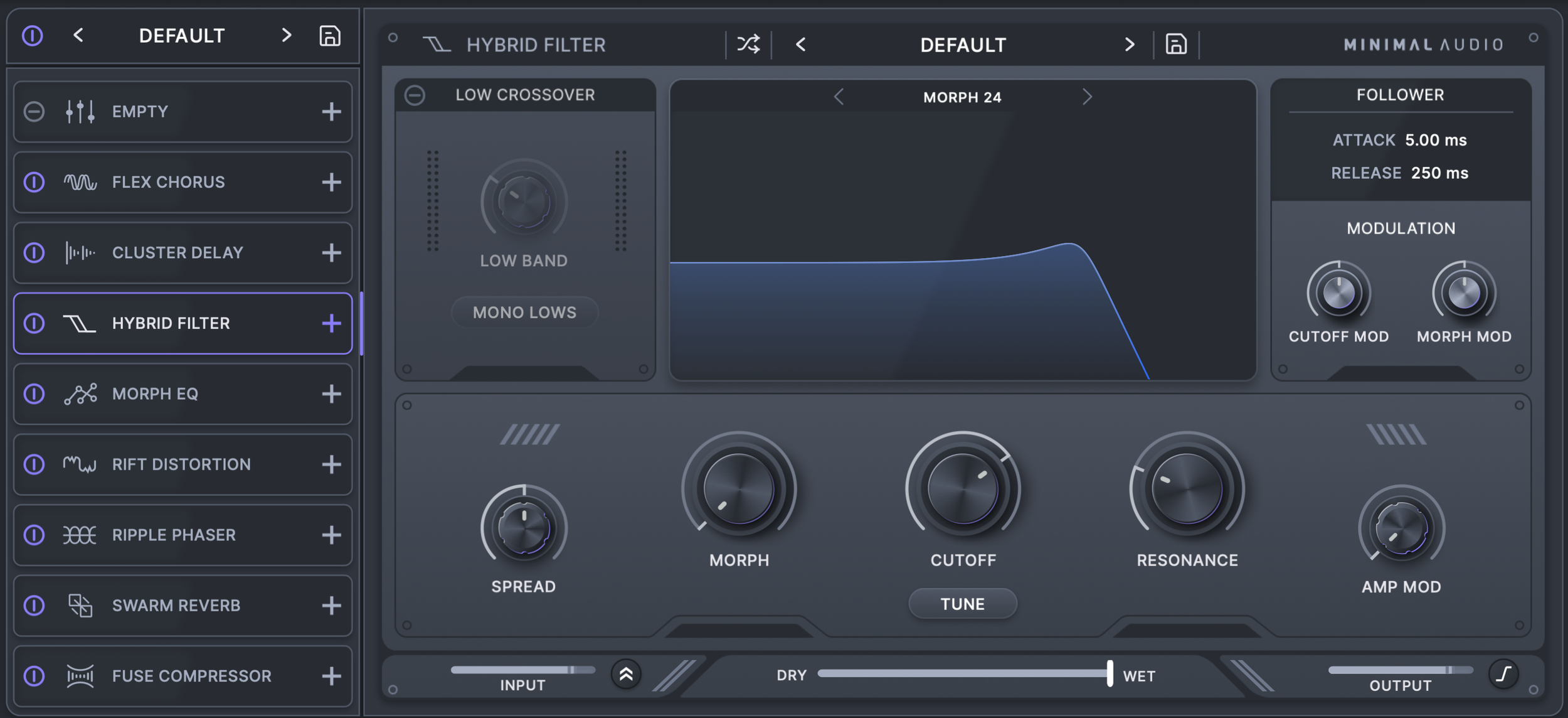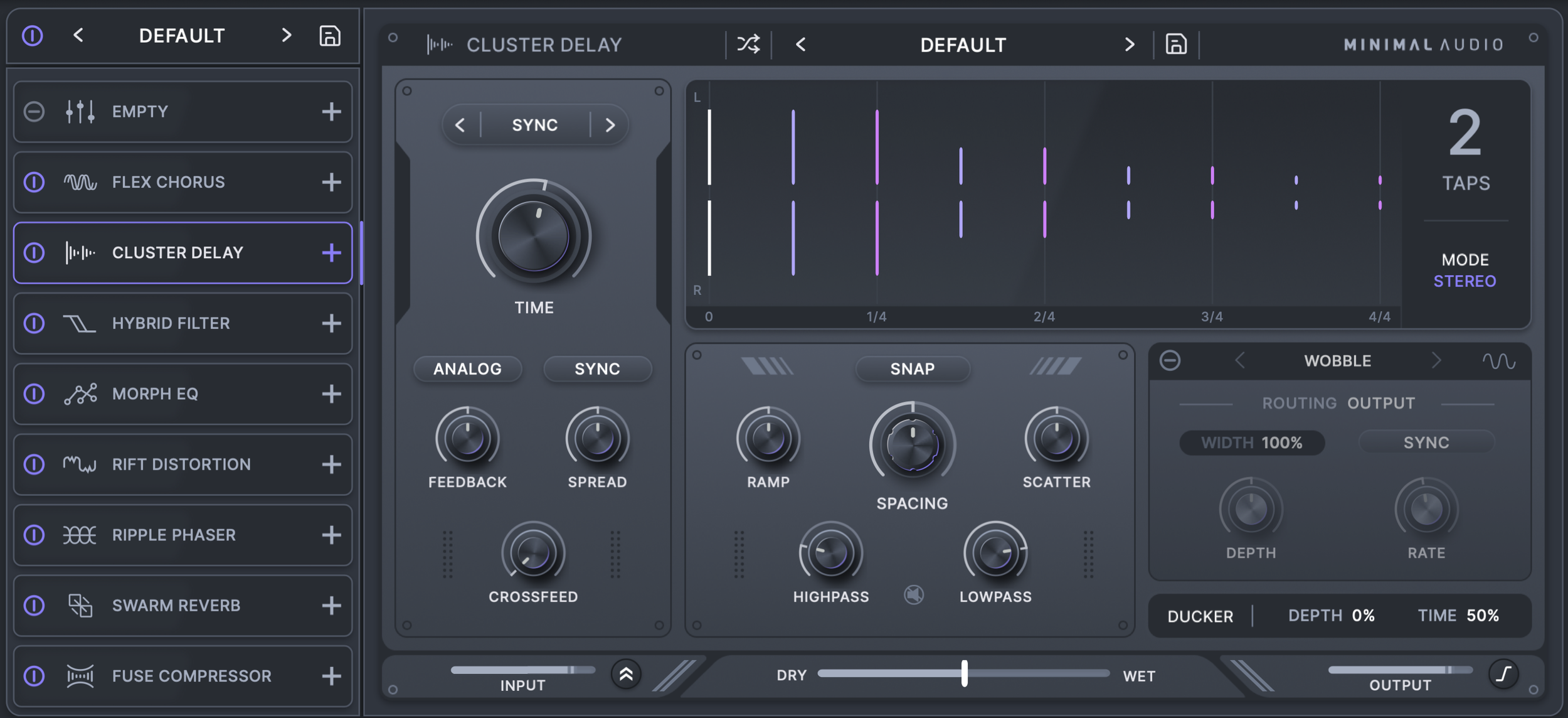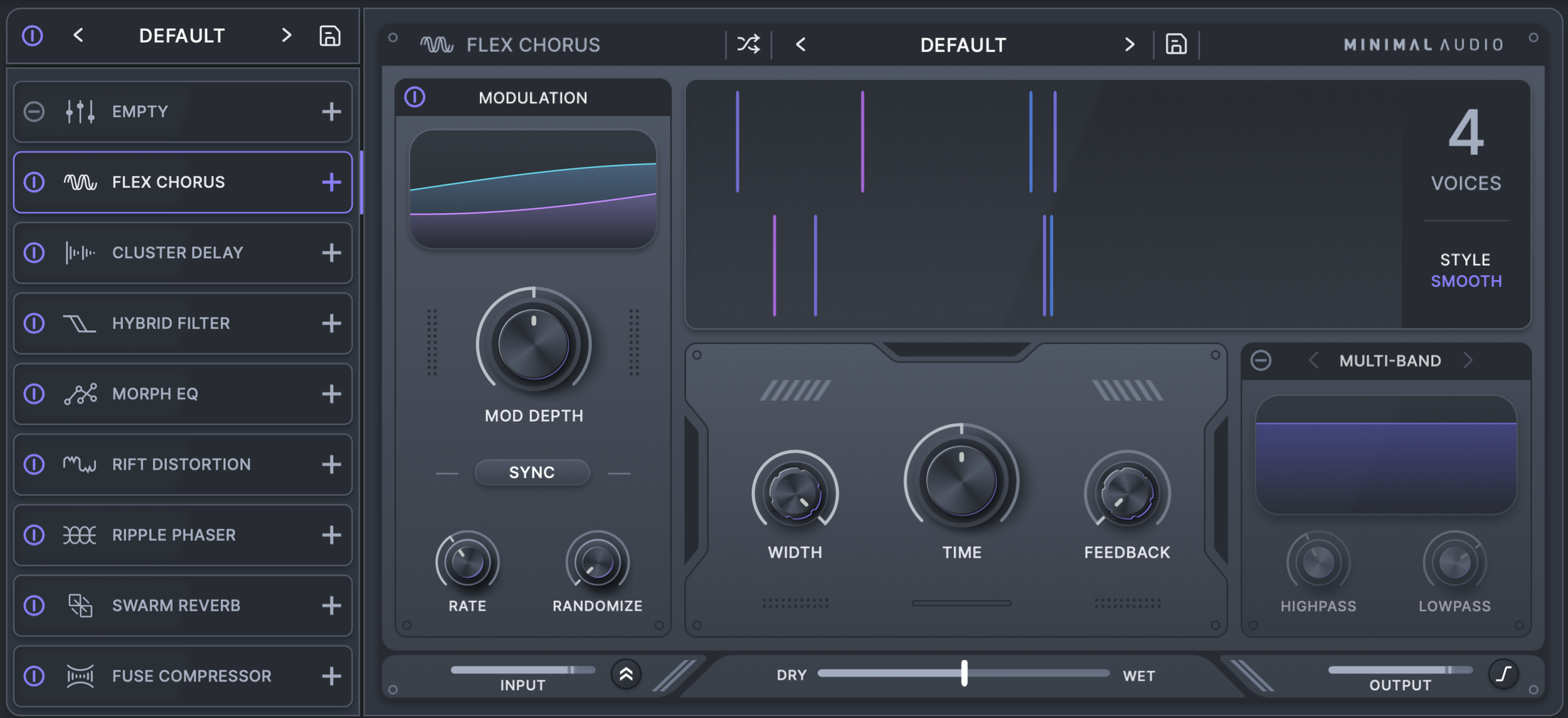CURRENT Review
Minimal Audio has given me a sneak preview of their new synth Current. The makers of Cluster Delay, Rift, and Morph EQ, Minimal Audio continually create awesome plugins that put a twist on existing ideas, so I was really excited to see them take on synthesis and sound generation. Current is a wavetable synth in the style of Serum and Vital, but with an additional granular generator added in. Where current really stands out from its competitors however is in the effects section, Current offers you nine effects slots capable of loading any of the eight included effects, this may not sound like much until you realize these effects ARE minimal audio’s effects plugins. You can load multiple instances of Morph EQ, Cluster Delay, and even Rift. The fact that fully fledged standalone effects are included as the effects section really steps up the sound design and experimental potential of Current. And if you haven’t already noticed, their UI looks incredible.
OSCILLATORS:
Current’s main engine contains five different oscillators; two wavetable, one granular, a sub, and a sampler. None of them are the most advanced out there, but they all offer at least some small unique details. In addition to the five oscillators there is an AM/FM page that allows for some simple routing between any of the oscillators. It’s not a full fledged matrix, you can only really route one thing to another, but feedback is possible and it’s a nice addition to the synth.
Wavetables: The core engine of current is the two wavetables, you can import any .wav format wavetable, and there’s a few algorithms for converting non wavetable samples into wavetables. Each wavetable includes two wave warping tools, similar to Vital one is distortion/phase based, and the other is spectral based. Unlike Vital the phase distortion comes before the spectral warping, giving it some unique capabilities not possible in any other synth. Additionally, remember that FM/AM are contained in their own section, meaning each wavetable oscillator actually has 3 wave warping capabilities, unlike using up the whole warp mode just for FM like in Serum. There’s 20 wave distortion modes and 23 spectral warp modes making for a wide variety of combinations , just using basic waveforms there is loads to explore here. These don’t replace vital or Serum though, where serum has a drawable phase distortion, and Vital has a drawable spectral filter. The main thing missing from these wavetable oscillators is unison spread for the position and warping controls, spreading these controls across unison voices is one of the most powerful tools in wavetable synthesis, I really hope they add this in a future update.
Granular: The granular engine is fairly basic, it’s not my favorite granular oscillator out there, but it’s powerful enough to get the job done. There’s all your standard controls with random spread for each, and a decent window shaper. You also get up to eight layers which you can arrange in a few different patterns, these stack up the granular engine in a way that can produce some pleasing comb phasing. Perhaps the most interesting aspect here is the ability to sync granular playback rate to note only BPM, but also note tracking. With the right settings this can produce pitched tones no matter what the input material is and allows for some interesting formant shifting and other creative sound design techniques.I really apreciate seeing the granular engine included, but I would have loved to see a bit more here, at the very least scales or octaves for the pitch random spread.
Sub: The sub is actually pretty neat, nothing too crazy, but the sub is semi additive, giving you up to 8 partials so you can get some nice overtones to the bass. The partials can be mixed in with a few different algorithms determining individual partial volume. This gets fed into its own mini distortion with several curves to choose from. Partials can even be slightly detuned and there’s a basic envelope built into the sub for giving it a bit of punch. If you consider this in combination with the FM, the sub makes for a fairly competent oscillator on its own.
Sampler: It’s a simple sample loader, you do get rough start/ end points and looping, but you can’t modulate any of it. There’s a built in basic filter for isolating frequencies, and even unison. I probably would have even given the sampler a mention however if it weren’t for the “flex” mode, which is a spectral time shift mode so samples play back at the same speed no matter which pitch you play them at. It’s a pretty nifty effect that can change your samples in some interesting ways. Flex mode lets you set the speed all the way down to freezing the sample, it has a very blurry quality to it, with a few different algorithms to find the best fit for input material.
FILTER:
Current has two morphing filters, basically the same filter from Rift, but with a few extra modes. Any oscillator can be routed into either filter, which can be routed in series or parallel. All your basic filter modes are here, and a decent variety of morphing filters, the morphing filters usually warp between a series of interesting shapes for much more dynamic tonal motion. Theres also a nice collection of formant, comb, and phaser shapes to choose from, if you want to get extra creative. I particularly enjoy the comb and flange shift modes, as the morphing seems to cause a very interesting push/pull effect.
EFFECTS:
Id have to say the effects section is the most interesting part of Current, not because anything else is lacking, but because of the inclusion of full versions of Minimal Audio’s standalone effects (with one exception*). Being able to load multiple instances of Morph EQ, Cluster Delay, and Rift makes for some very powerful effects shaping. If I had to guess, I’d assume that many of the other effects will join the Minimal Audio plugin lineup soon. It’s also worth noting that these effects also load the presets of their standalone counterparts. Most controls on these effects accept modulation, having this caliber of an effects section is more fun than I expected, it’s like having a plugin chain built into the synth. I do hope in the future they add a few more effects, something granular would have been nice, maybe pitch shifting or spectral processing as well. I will have full reviews of most of these effects eventually, links will be added as I create them.
*Rift Distortion: Rift is the one exception, the’ve seemingly split Rift up, you only get the distortion portion of rift, not the rift filter or feedback, these seem to have been stripped out and turned into the “hybrid filter”. Also missing are the modulation sources and macros from the plugin version of Rift and even some of the multi staging. Otherwise you get the same distortion modes, multi-band and asymmetric splitting. This is such a great distortion to have included in the effects section of a synthesizer, being able to stack and layer instances of Rift provides ample control over preset tonal shaping. I will have a full review of Rift soon
Hybrid Filter: Same as the generator filter section, but with some amplitude modulation and a crossover to isolate the lows. Between this and instances of Morph EQ you can get some pretty wild tonal shaping.
Morph EQ: A full on equalizer, great to have included in a synth, especially considering the whole “Morph” aspect of it. Check out my full review here:
Cluster Delay: One of the more powerful delays to be included in a synth, very fun for experimental sound design. Check out my full review here:
Fuse Compressor: A powerful “OTT clone” style multi-band compressor, I love the sound of it. Fuze gives you quite a bit more control compared to OTT, but also has some convenient macros making it just as easy to use as well. There’s up to six bands total and full control over crossover frequency.
Flex Chorus: A pleasant multi delay based chorus with up to 24 voices. Randomized motion gives it some ensemble characteristics, and two delay styles make it either diffuse or glossy. There’s also a multi-band splitter to apply the effect to specific frequency ranges.
Ripple Phaser: If the filter phaser wasn’t deep enough, this one provides a few more options, it can be frozen and used as a filter as well. Motion can be randomized or applied differently per stereo channel. Bend and spread controls alter the overall shape of the phaser, which can have up to 12 notches. The internal modulation doesn’t have to be applied to the center frequency either, it can be placed more towards modulating bend or spread as well, creating some interesting alternative phasing styles. Finally there are multiple flavors to chose from as well under the “styles” control.
Swarm Reverb: probably the most underwhelming of the effects. It’s a great sounding reverb, there’s a fair bit of shaping options. but it’s generally pretty vast sounding. I wish there was a bit more fine control over the wet to dry ratio, it seems like I have to pull it down way further than I’d expect to get an appropriate balance, but perhaps my tastes have changed.
MODULATION:
Current’s modulation is a bit on the basic side, you get nine total modulators, which is less than most of this style of synth, but you can set any of these nine modulators to either of the four modulation types. This means you can have nine drawable MSEGs, or nine randomizers, so in that sense it does offer a bit extra depending how you look at things. Modulation is done via drag and drop and the system works fairly smoothly, it’s also pretty neat that you can change modulation type after it is routed, which can save some time durring experimentation, or even lead to new unexpected ideas.
Envelope: The envelope mode is pretty decent, you full on AHDSR, with curve control over each stage. You can also sync the envelop to tempo which is a very pleasant addition.
LFO: Your bog standard LFO, you get the basic LFO shapes and some morphing between, and a control to randomize them for using the LFO as a sample hold or randomizer.
Curve: This is your MSEG, you can draw point by point or use some of the various drawing tools to create custom patterns, The brush types can all be morphed as well for quite a few more options. One of the best inclusions here is the shape randomizer, which outputs a random curve shape depending on the grid settings. This almost completely removes the need for MSEG banks, you can just click thorough a variety of randomized shapes, all based off of a few different pattern types, from stepped, to smooth, to a combination of shapes. It’s a fun way to take a sound and get some unique motion out of it.
Follower: Something neat I don’t see often on synths is an envelope follower, this one can detect any oscillator and use it as a modulation source. I haven’t found much use for this yet, but it can be a nice way to get some cross communication going on between elements.
CHORD/ARP:
One of the more interesting inclusions to Current is the chord and arp pages. The chord mode play entire chores per note, you can even apply different inversions and chord types per scale degree. I haven’t quite wrapped by head around it, but it’s a fun way to get some more interesting music theory ideas than you might normally be used to. Next is the arpeggiator, which can do all your normal octave and playback patterns, but there’s also some unique patterns, and a variety of rhythms to choose from. The arp doesn’t restrict you to octaves either like most arps, it can be set to shift each step by any given interval. Lastly for the arp section, there’s a skip control, which randomly skips arpeggiator steps, adding even more variety to the mix. The chord engine feeds directly into the arp as well, both of which can be locked to basic scales and modes, making for some incredibly easy melody generation. This section is a blast to play with and create melodic content with, it’s just a full on idea generator.
So far I have found Current to be best for leads, the sonic character and the included effects make it perfect for creating energetic and emotive leads ina. way I haven’t quite been able to match on alternative options. Stacking equalizers, distortions and applying motion that is built into the synth make it perfect for dialing in the subtle character necessary for great leads. Don’t get me wrong, Current is more than capable of awesome pads, atmosphere, sound design and bass, but it just covers the lead role so well. I’ve also found the combination of effects and wavetable features perfect for glassy plucked instruments. Being able to stack up subtle distortion and compression ends up creating a powerful tone that would normally necessitate a channel strip or plugin chain after the main synthesizer. Over all I don’t think Current quite replaces anything, it does a lot of unique things, that together add up to something quite interesting and powerful, but none of those individual parts really blow anything out of the water on their own. I really enjoy what they’ve done with this one and plan on using it quite a bit in the future. The combination of effects, modulation, and granular/ sample engines also make an incredible glitch generation tool as well.

